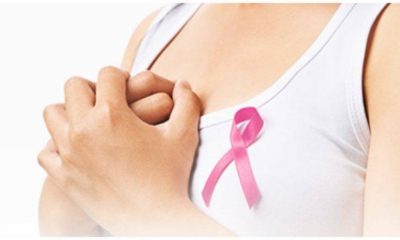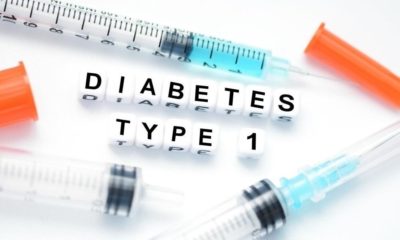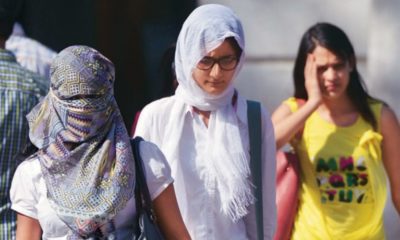Feature
Mexican student fits bra with mobile application to detect breast cancer

Mexico City: A device made of a brassiere cup fitted with a mobile application, developed by a Mexican student, is designed to be an ally of mammograms for the timely detection of breast cancer in women with very dense breast tissue and in those under age 40.

“The idea started after my mother had to deal twice with that illness. She had her breasts removed and almost lost her life because of a bad diagnosis,” Julian Rios, inventor of Eva, the first personal, non-invasive method of evaluating the risk of breast cancer, told international news web portal.
Eva is cup that goes inside a bra and with a mobile app begins its exploration. In just five minutes it can determine whether or not a woman is at risk of breast cancer.

The device functions through an analysis of thermal patterns in the mammary gland and focuses on women with very dense breast tissue, as well as on women under ages 35-40.
The idea was to find a procedure more certain than self-exploration and less dangerous than mammograms, “since the device generates nothing in the way of heat or radiation, nor is it painful since it doesn’t squeeze the breast”, Rios said.

According to the National Breast Cancer Foundation, the radiation and squeezing involved in this kind of treatment can cause the metastasis of carcinogenic cells to other parts of the body.

Mexican student develops bra fitted with mobile app to detect breast cancer:

Eva has at least 200 small biosensors capable of mapping the surface of the breast and determining, for example, the thermal conductivity by areas.
More heat in a certain area signifies a greater blood flow, which means that something is feeding those blood vessels, which would normally be a cancer.

“Eva functions through an analysis of the breast temperature and with algorithms predicts if you run the risk of having a malignant or benign mass in the breast, and since it doesn’t squeeze the breast, it’s good for young women,” Rios said.
He said mammograms for women with high breast density have a 70 percent sensitivity, “which is not much use, but our sensitivity is almost 87 percent”. He added, however, that “this doesn’t replace mammography but rather complements it”.

At the moment, he said, the project had an investment of $5 million contributed by various US and European foundations and by individuals like actors Ashton Kutcher and Leonardo Di Caprio as well as writer Jessica Livingston.

Rios added that while Eva was not yet available on the market, in Mexico he was currently doing tests with the Mexican Social Security Institute (IMSS) and with the Salud Digna association. The idea was that in 2019 clinical trials will be carried out at a number of medical centres around the country.
Entertainment
Meghalaya Reserves Legalized Gambling and Sports Betting for Tourists

The State Scores Extra High on Gaming-Friendly Industry Index
Meghalaya scored 92.85 out of 100 possible points in a Gaming Industry Index and proved to be India’s most gaming-friendly state following its recent profound legislation changes over the field allowing land-based and online gaming, including games of chance, under a licensing regime.
The index by the UK India Business Council (UKIBC) uses a scale of 0 to 100 to measure the level of legalisation on gambling and betting achieved by a state based on the scores over a set of seven different games – lottery, horse racing, betting on sports, poker, rummy, casino and fantasy sports
Starting from February last year, Meghalaya became the third state in India’s northeast to legalise gambling and betting after Sikkim and Nagaland. After consultations with the UKIBC, the state proceeded with the adoption of the Meghalaya Regulation of Gaming Act, 2021 and the nullification of the Meghalaya Prevention of Gambling Act, 1970. Subsequently in December, the Meghalaya Regulation of Gaming Rules, 2021 were notified and came into force.
All for the Tourists
The move to legalise and license various forms of offline and online betting and gambling in Meghalaya is aimed at boosting tourism and creating jobs, and altogether raising taxation revenues for the northeastern state. At the same time, the opportunities to bet and gamble legally will be reserved only for tourists and visitors.
“We came out with a Gaming Act and subsequently framed the Regulation of Gaming Rules, 2021. The government will accordingly issue licenses to operate games of skill and chance, both online and offline,” said James P. K. Sangma, Meghalaya State Law and Taxation Minister speaking in the capital city of Shillong. “But the legalized gambling and gaming will only be for tourists and not residents of Meghalaya,” he continued.
To be allowed to play, tourists and people visiting the state for work or business purposes will have to prove their non-resident status by presenting appropriate documents, in a process similar to a bank KYC (Know Your Customer) procedure.
Meghalaya Reaches Out to a Vast Market
With 140 millions of people in India estimated to bet regularly on sports, and a total of 370 million desi bettors around prominent sporting events, as per data from one of the latest reports by Esse N Videri, Meghalaya is set to reach out and take a piece of a vast market.
Estimates on the financial value of India’s sports betting market, combined across all types of offline channels and online sports and cricket predictions and betting platforms, speak about amounts between $130 and $150 billion (roughly between ₹9.7 and ₹11.5 lakh crore).
Andhra Pradesh, Telangana and Delhi are shown to deliver the highest number of bettors and Meghalaya can count on substantial tourists flow from their betting circles. The sports betting communities of Karnataka, Maharashtra, Uttar Pradesh and Haryana are also not to be underestimated.
Among the sports, cricket is most popular, registering 68 percent of the total bet count analyzed by Esse N Videri. Football takes second position with 11 percent of the bets, followed by betting on FIFA at 7 percent and on eCricket at 5 percent. The last position in the Top 5 of popular sports for betting in India is taken by tennis with 3 percent of the bet count.
Local Citizens will Still have Their Teer Betting
Meghalaya residents will still be permitted to participate in teer betting over arrow-shooting results. Teer is a traditional method of gambling, somewhat similar to a lottery draw, and held under the rules of the Meghalaya Regulation of the Game of Arrow Shooting and the Sale of Teer Tickets Act, 2018.
Teer includes bettors wagering on the number of arrows that reach the target which is placed about 50 meters away from a team of 20 archers positioned in a semicircle.
The archers shoot volleys of arrows at the target for ten minutes, and players place their bets choosing a number between 0 and 99 trying to guess the last two digits of the number of arrows that successfully pierce the target.
If, for example, the number of hits is 256, anyone who has bet on 56 wins an amount eight times bigger than their wager.








































